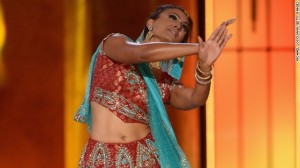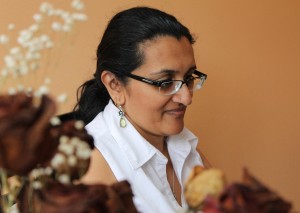Miss America is Indian-American: Yay, I think. Or not.
By Guest Contributor on September 30, 2013By Archana A. Pathak
Two weeks ago, an Indian-American woman won Miss America, and the ensuing days elicited varying commentaries on this “historic moment.” It all started with the comments out in the twitterverse:
How the fuck does a foreigner win miss America? She is a Arab! #idiots
Asian or indian are you kiddin this is america omg
Congratulations Al-Qaeda. Our Miss America is one of you.
Miss America? You mean Miss 7-11.
More like Miss Terrorist #MissAmerica
and continued with, expectedly, Fox News commentary.
Then we saw some responses to those comments:
http://www.youtube.com/watch?v=WuEWTm7Vk0U
https://thefeministwire.com/2013/09/intersectionality-for-racists/?fb_source=pubv1
The responses call to address intersectionality and the ways that despite Davuluri’s win, we cannot lose sight of intense sexism and patriarchy of pageants.
To me, this “historical” moment is more complex and complicated than the obvious mix-ups about Nina’s ethnicity, religion, values, origins, political affiliations, citizenship, etc.; or the obvious sexism of women being paraded on national television in bikinis.
 It’s strange writing this essay as an Indian-American. I craved acceptance as a young child (and still do sometimes) and wanted my ways of being, my world at home, to fit in with the outside world I continuously navigated. Nina Davuluri’s win gives that acceptance to young Indian-Americans today. And yet, I find myself asking, at what cost is this acceptance?
It’s strange writing this essay as an Indian-American. I craved acceptance as a young child (and still do sometimes) and wanted my ways of being, my world at home, to fit in with the outside world I continuously navigated. Nina Davuluri’s win gives that acceptance to young Indian-Americans today. And yet, I find myself asking, at what cost is this acceptance?
If we are to really think through this moment, we’ve got to examine the whole story with all its contradictions.
To begin, this is the first time an Indian-American woman has been named Miss America. That’s interesting in and of itself, given that people from the South Asian subcontinent have been in the U.S. since the 1800s. (Some anecdotal evidence indicates that they may have been present for the Boston Tea Party; which makes sense if you think about where all that tea came from).
But, beyond the obvious issue (it took the Miss America pageant until 1984 to crown an African-American Miss America), this moment opens the door to more complicated and complex questions about race, gender, and nation. And, of course, we need to think about the multiple audiences that are reading/responding to/impacted by this event.
I want to say that I am proud of Nina Davuluri. It’s great that she won and I don’t necessarily question her choices, efforts, and success or deny her the pride, prizes, status, honor, and so on that comes from all of this.
And, as a public figure, she, her life, and her actions become a site of cultural analysis, and the ways in which she is “consumed” (Narayan, 1994) serve as fertile ground for a larger discourse on race, class, gender, and nation.
If we look at who made it to the top 10 and the top five, on the surface we do see a bouquet of representative America – where women of all colors, creeds, walks of life can and do represent this fine nation. We have Asian-Americans, an African-American woman, white women; military women, Southern, Northern, Western, Midwestern, Southwestern women; we have blondes, brunettes, redheads. It looks different, and yet it’s not quite as different as we might think. Much like a Benetton advertisement, the women more or less fall into cookie cutter representations of femininity, body type, ability, and ethnicity. While Nina’s platform is diversity, she still fits a very specific box in terms of gender, sexuality, and Indianness. Indeed, she embodies the safest and most dangerous form of diversity – that which is palatable to the dominant mainstream.
Let’s take this piece by piece:
First off, the crowning of a non-white, non-Black Miss America opens the door to a reality that is often overlooked in race discourses. The move toward other ethnic groups is an important one as we openly recognize the ethnic and racial diversity of the U.S. It is important to find as many ways as possible to expand our race discourse beyond Black/White if we are to fully address the impacts of racism in the U.S. Until we do, we cannot fully heal. And at the same time, Nina isn’t alone in her win. It reveals our own selective memory. In 2001, Angela Perez Baraquio, was the first Asian-American crowned Miss America. An Arab was named Miss USA in 2010 (I know, it’s a different pageant, but the argument still stands). By now, there have been several African-American Miss Americas (seven to be exact). (See Watson & Martin, 2004)
I am also cautious when “diversity” is presented through Asian Brown bodies. While we celebrate our recognition, we must simultaneously ask, in celebrating us, who gets put to the side? Which bodies are being denied access, representation? Additionally, the celebration of Indianness is fraught with echoes of a colonial memory. An exotic, spiritual culture that invokes ancient cosmic forces and a nostalgia of exquisite femininity (read: submissive, subtly sexual, silent), its celebration can and is often a powerful tool of empire. The question we really need to ask is, what parts of her Indianness does Nina get to put on display? To what extent and why? These questions and their answers tie directly into the model minority myth that remains pervasive in U.S. society (Bhatt, 2003). And that then ties directly to the ongoing agenda to divide and conquer by pitting Asianness/Brownness against Blackness/Latina-ness.
This is further exemplified through Said’s (1978) eloquent argument that diversity is a tool of empire. Nina embodies in many ways the pervasive and damaging discourse of how diversity is now cultural currency and brings with it a cache, particularly for liberal America. It’s cool to be “ethnic,” to have a story, a culture that one can “harken back to” as long as it’s dished out (literally in “ethnic” cuisine restaurants) in small, palatable doses that are altered enough to only hint at the spiciness of that life and to add a bit of flavor to the base of common Americanness. And this common Americanness gets read as bland, culture-less, non-ethnic (read: white).
There are two key issues here: the first is that the mainstream continues to define Indianness (or ethnic) only so far as to make themselves feel better about themselves, and the second is that in naming diversity, we’ve reinforced the white/non-white binary in which whiteness continues to hold the place of the mythical norm (hooks, 2000). Even Nina’s call for diversity fits the irony of how she then upholds empire. Her dance is beautiful but a loose, limited amalgam of varying traditional and modern styles. While mixing styles is no sin (with respect to all the classical Indian dance teachers out there), when it is done and then presented as “Indianness,” it only serves to entertain and awe, not engage or share a cultural reality. Indeed, some comments to her dance posted on YouTube stated, “Don’t know if she’s any good or if it’s right, but it’s cool.” The actual dance and its art are irrelevant here. Blind acceptance is as racist as blind rejection. Here we see the ways in which seeking legitimacy in the dominant mainstream is encouraged through the prevalent practices of cultural consumption. We often mistake being spectacle as being understood/accepted. It is no wonder, given the powerful ways in which cultural appropriation and consumption are tied to consumerist practices. Such moves bring “Americans” into our communities to spend money; we can find our needs (foods, clothing, accessories) in mainstream locations.
 That said, Nina’s dance is quite representative of the multitudes of performances happening all throughout the South Asian diaspora. Indeed, Nina is the quintessential Indian-American girl, or is she? We also have to look at the responses from within the Indian-American community. Of course, as soon as she won, my Facebook newsfeed was peppered with comments about a “Desi” winning Miss America and how Indian parents didn’t have to worry because she was in med school. Nina exemplifies a heteropatriarchal, model minority representation of Indianness. She is cisgendered and hyper feminine; class privileged; presumptively heterosexual, but not sexualized (except the bikini of course; one does what they must to fit in. Despite the shifting attitudes in South Asian cultures, women are still expected to present their bodies modestly. And, both in South Asian cultures and U.S. culture, the bikini highlights a woman’s body as sexual parts focusing attention on her breasts, the juncture of her thighs and her rear end); fulfilling the model minority/American dream of success through very narrow specified educational practices; and yet able to celebrate her true cultural heritage.
That said, Nina’s dance is quite representative of the multitudes of performances happening all throughout the South Asian diaspora. Indeed, Nina is the quintessential Indian-American girl, or is she? We also have to look at the responses from within the Indian-American community. Of course, as soon as she won, my Facebook newsfeed was peppered with comments about a “Desi” winning Miss America and how Indian parents didn’t have to worry because she was in med school. Nina exemplifies a heteropatriarchal, model minority representation of Indianness. She is cisgendered and hyper feminine; class privileged; presumptively heterosexual, but not sexualized (except the bikini of course; one does what they must to fit in. Despite the shifting attitudes in South Asian cultures, women are still expected to present their bodies modestly. And, both in South Asian cultures and U.S. culture, the bikini highlights a woman’s body as sexual parts focusing attention on her breasts, the juncture of her thighs and her rear end); fulfilling the model minority/American dream of success through very narrow specified educational practices; and yet able to celebrate her true cultural heritage.
Up against that, we must also address the fact that Nina, as an Indian-American from the South of India isn’t considered quite up to par within the Indian and Indian diasporic communities where colorism is rampant. She’s “dark.” Indeed, look at India’s representatives in the Miss Universe/Miss World pageants. Nina comes from a region of India that has been less publicly represented amongst the diaspora. As an Indian-American from the Northwest (often the more privileged subset of the diasporic community), I must attend to the fact that there was very little media about Nina’s win amongst Northern/Northwestern Indian diasporic communities. She may not quite be the Indian-American we want to represent us.
We also have to at least consider the shifting signifier of “Asian” in this discourse. It’s important that Nina slides between the space of Indian-American and Asian-American throughout the competition. She refers to herself as both onscreen. For the U.S., how the South Asian subcontinent is positioned geopolitically is either absent or irrelevant. But the question of whether Nina is Asian-American or Indian-American or both speaks to the ways in which racism and imperialism are connected. It begs the question of who America sees as Asian. And, it complicates the ways in which America understands Arab, Muslim, terrorist, Middle East, etc.
And finally, we cannot ignore the ways in which sexism and patriarchy are so very present in all of this. DasGupta (2013) does a brilliant job addressing this in her essay. I would only add a few additional comments. If anything, Nina’s win epitomizes Audre Lorde’s comment, “The master’s tools will not dismantle the master’s house.” Even in the moment of breaking racial boundaries, Nina concretized sexism. Though not garnering much attention, there was rumor that either she or one of her friends made disparaging comments about the former Miss America, calling her a fat cow. Nina has gone on record claiming it wasn’t her and that she apologized for her friends. But it doesn’t really matter does it? Because the whole point is to be palatable to the mainstream. Nina’s brownness/Indianness fits the mold; is it any surprise that she polices other women?
So, I am both thrilled and dismayed that Nina Davuluri won the 2014 Miss America pageant. Over the next few months, I will attend to this inevitable conversation of explaining why it’s not just as simple as another win for Indian-Americans and why these types of wins might actually be setting us back further than we even imagined.
______________________________________
 Archana A. Pathak (Ph.D. 1998, University of Oklahoma) is an assistant professor in the Gender, Sexuality & Women’s Studies Department at Virginia Commonwealth University. As a scholar activist, a key focus of her research is on diasporic communities as they navigate multiple identities of race, nation, class, gender, and sexualities.
Archana A. Pathak (Ph.D. 1998, University of Oklahoma) is an assistant professor in the Gender, Sexuality & Women’s Studies Department at Virginia Commonwealth University. As a scholar activist, a key focus of her research is on diasporic communities as they navigate multiple identities of race, nation, class, gender, and sexualities.
She has been broadly published with her most recent articles including: “Opening my voice, claiming my space: Theorizing the possibilities of postcolonial approaches to autoethnography” in the Journal of Research Practice, 2010. “Being Indian in the U.S.: Exploring the hyphen as an ethnographic frame” in the International and Intercultural Communication Annual, vol. XXXI. And, “The Sita syndrome: Examining the communicative aspects of domestic violence from a South Asian perspective” in the Journal of International Women’s Studies.
She also serves as the current President of the Board of Directors for The Conciliation Project, a non-profit social justice organization that works to facilitate dialogue about oppression through theatrical performance. She served as an Advisory Board Member for A More Perfect Union, a project on developing anti-bias education for the greater Richmond Metro area to decrease bias against Muslims, Arabs and South Asians, including coming up with effective projects for the grant, implementing these projects and assessing the effectiveness of these projects.
You may also like...
5 Comments
All Content ©2016 The Feminist Wire All Rights Reserved




Pingback: Lovely Links: 10/4/13